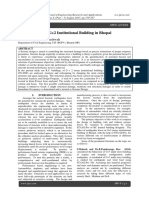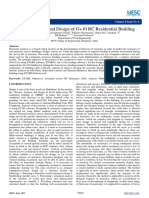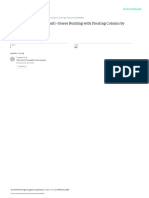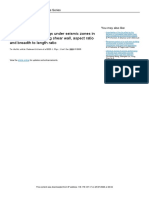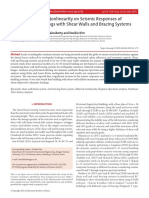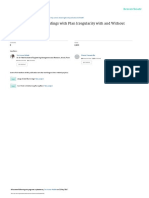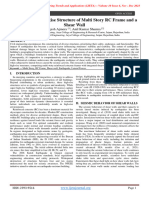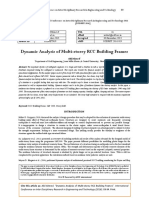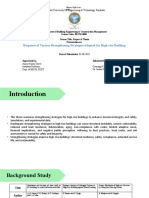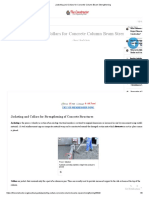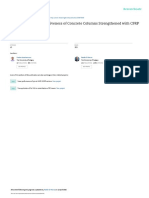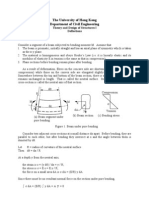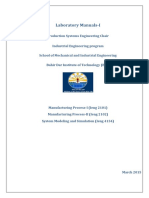Seismic Response Analysis of Tall Building Using STAAD Pro Software
Seismic Response Analysis of Tall Building Using STAAD Pro Software
Uploaded by
sp thipathiCopyright:
Available Formats
Seismic Response Analysis of Tall Building Using STAAD Pro Software
Seismic Response Analysis of Tall Building Using STAAD Pro Software
Uploaded by
sp thipathiOriginal Title
Copyright
Available Formats
Share this document
Did you find this document useful?
Is this content inappropriate?
Copyright:
Available Formats
Seismic Response Analysis of Tall Building Using STAAD Pro Software
Seismic Response Analysis of Tall Building Using STAAD Pro Software
Uploaded by
sp thipathiCopyright:
Available Formats
See discussions, stats, and author profiles for this publication at: https://www.researchgate.
net/publication/339569841
Seismic Response Analysis of Tall Building Using STAAD Pro Software
Article · February 2020
DOI: 10.5281/zenodo.3685732
CITATIONS READS
0 118
2 authors, including:
Sangeeta Uikey
Rajiv Gandhi Proudyogiki Vishwavidyalaya
2 PUBLICATIONS 0 CITATIONS
SEE PROFILE
Some of the authors of this publication are also working on these related projects:
SEISMIC RESPONSE ANALYSIS OF TALL BUILDING USING STAAD PRO SOFTWARE View project
All content following this page was uploaded by Sangeeta Uikey on 28 February 2020.
The user has requested enhancement of the downloaded file.
Journal of Earthquake Science and Soil Dynamics Engineering
Volume 3 Issue 1
DOI: http://doi.org/10.5281/zenodo.3685732
Seismic Response Analysis of Tall Building Using STAAD Pro
Software
Sangeeta Uikey1*, Er. Rahul Satbhaiya2
1
M.Tech Scholar, Department of Structural Engineering, Infinity Management &
Engineering College, Sagar, M.P., India.
2
Assistant Professor, Department of Civil Engineering, Infinity Management & Engineering
College, Sagar, M.P., India.
*Corresponding author
E-mail id:-sangeeta.uikey2011@gmail.com
ABSTRACT
The main objective of this whole project is to Seismic Response Analysis Of Tall Building
Using Staad Pro Software Load calculations are done manually and analysis of whole
structure by STAAD Pro Software. Limit State Design conforming to Indian Standard Code of
Practice is method used in STAAD-Pro analysis for designing. STAADPro is the software of
professional’s choice. I had done the analysis of frames and manually checked the accuracy
of the software with our results obtained. The results proved to be very precise and accurate.
Ihad analyzed and designed a G+4, G+9, G+14, & G+19 storey building and checked it for
all possible load combinations (Dead, live, wind and seismic loads). STAAD.Pro has a very
user friendly and interactive user interface, which allows the users to simply draw the frame
and command the load values and dimensions. Then as per the specified criteria assigned, it
analyses the whole structure and it also analyze the structure in different seismic Zone given
by our code. The materials was chosen and geometric cross-sections of the beam and column
members has assigned. Fixed support has been fixed for whole analysis. Codal provision to
be followed has also been specified for design purpose with other important details. Then
STAAD.Pro has been used to analyze the structure. It can easily determine the parameter like
Lateral forces, bending moment, Shear force, & axial force.
Keywords:-Lateral forces, bending moment, Shear force, axial force, seismic response.
INTRODUCTION has become extremely important
The recent earthquakes in India has shown concern[21,22,23]. In particular, the
increase in the seismic zoning factor over seismic rehabilitation of old RCC
various parts of the country [13,14,15]. In structures in high seismicity areas is a
addition to this, ductility has become an matter of growing concern, since
significant issue for all those buildings that structures.In earthquake design, the
has designed and detailed using earlier building has to go through regular and
versions of the IS codes [16]. Various repetitive motion at its base, which induce
concrete structures have collapsed or to inertia force in the building that
severely damaged during these consecutively causes stresses[24,25,26]
earthquakes[1,2,17,18]. This shows the
importance for evaluating the seismic OBJECTIVES
adequacy of buildings already constructed The objective of the study are as follows:
[19,20]. India’s 60% of land constitute 1) Evolution of performance of RC frame
these four zones [10,11,12]. Under such building under seismic zone.
conditions, seismic qualification of 2) Compare the performance of structure
existing buildings under revised IS codes in different seismic zone and soil
HBRP Publication Page 1- 7 2020. All Rights Reserved Page 1
Journal of Earthquake Science and Soil Dynamics Engineering
Volume 3 Issue 1
DOI: http://doi.org/10.5281/zenodo.3685732
condition. (vertical regular and vertical irregular)
3) To compare the seismic response of having (G+9) stories with different bracing
multistoried buildings without shear wall systems were analysed by response
in terms of Storey drift and Average spectrum method using ETABS. Outcomes
displacement. corresponded to displacement, storey drift
and storey shear was compared. In this
research , researchers concluded that both
regular and irregular RCC frame structures
X- bracing gives less displacement, storey
drift and base shear. Regular frame bears
more stiffness than irregular frame. Steel
bracing were used to strengthen and
retrofit existing structures. [5]
Mohammad A. et al. (2016) - donea
numerical approach to show dissimilarity
between shear wall and steel bracing
Fig.1:-Earhtquake In Nepal systems. The new methodology of this
research was to strengthened lateral force
RELATED WORK resisting system via steel bracing. A
Kuldeep dubey & Rakesh patel (2018) - measured has been done step by step to
floating column then the cost of building is show understandable contrasts between
increases due to increase in reinforcement systems. The overall investigation has
& concrete but building gives satisfactory been carried out by response spectrum
results and the with floating column. [3] using ETABS 9.7 that is of six case
studies. It is coherent that model 1 (shear
Anes B et al. (2017) - deal with effect of wall at core) is the safest among six
steel bracings on RC framed structures. models assessed in the research tenacity.
Reinforced concrete building (G+9) was Positioning of shear wall is a principal
shaped and analysed in three parts point. Besides, the orientation in floor
comprising model sans steel bracing and bracing is of less significant dissecting
shear wall, with dissimilar bracing with the vertically oriented bracing
systems, with shear wall. Bracings and systems. Further modification in floor
shear wall were positioned at the middle bracing will escort good formulation as
bays and all these simulations were seismic force resisting system. [6]
analysed for seismic forces at seismic
zones II, III, IV and V using ETABS 2015. Anirudh Gottala, Kintali Sai Nanda et
As per conclusion chevron category of al (2015) - has done comparative study of
steel bracing was originate to be more static and dynamic seismic analysis of a
effectual in zones II and III, X type tall building. A multi-storied framed
bracing was originate to be more effective structure of (G+9) pattern has been
in zones IV and V. Steel braced building selected. Seismic analysis linearlyhas been
significantly decreases the lateral drift done for the tall building by static method
when associated with shear wall building. (Seismic Coefficient Method) and dynamic
[4] method (Response Spectrum Method)
using STAAD-Pro as per the IS-1893-
Rakshith (2017) - examined effect of 2002-Part-1. A comparison has been done
bracings on Multi-Storied RCC building between the static and dynamic analysis
under dynamic loading. RCC building and the results such as Bending moment,
HBRP Publication Page 1- 7 2020. All Rights Reserved Page 2
Journal of Earthquake Science and Soil Dynamics Engineering
Volume 3 Issue 1
DOI: http://doi.org/10.5281/zenodo.3685732
Nodal Displacements, Mode shapes are MEMBER LOADING
computed, compared and summarized for All the members has assigned the
Beams, Columns and Structure as a whole following loading
during both the analysis.[7] Self-weight
Live load
METHODOLOGY AND DISCUSSION Earthquake load as per IS-
MODELLING OF FRAME code:1983:2002/2005
All the preliminary modelling has done in It was assumed that the wind force
STAAD Pro. V8i by using staad modelling was not governing the frame
tools, A 5,10,15 & 20 storey frame was efficiency
modeled in STAAD Pro. Along with the
above frame. The main aim is to compare LOAD COMBINATION
storey drift, storey deflection, bending In this project we will generated load
moment & shear forces [27,28]. combination during analysis process. The
All the beam is the frame for 5, 10, 15 generate load combination is the
&20 storey were size to combination of the load obtained as per
(0.23x0.35)mm when we go more code in this project we are following
than G+9 storey building then we used Indian standard code design criteria so the
this value of column. load generated by the STAAD Pro. V8i
All the beam is the frame for 5, 10, 15 has based on concrete design type using
& 20 storey were size to(0.23x.30)mm IS1893:2002/2005. Load combination
All the column is the frame for 5, 10, generated as follows: [12]
15 & 20 storey were size to
(0.23x0.46)mm
Table 1:-Load cases details
Load case no. Load cases
1 D.L
2 L.L
3 EQ_X +VE
4 EQ_X -VE
5 EQ_Z +VE
6 EQ_Z -VE
7 1.5(D.L+L.L)
8 1.2(D.L+L.L+EQ_X) +VE
9 1.2(D.L+L.L+EQ_X) -VE
10 1.2(D.L+L.L+EQ_Z) +VE
11 1.2(D.L+L.L+EQ_Z) -VE
RESULT results are obtained as deflected shape,
This chapter present the results on RCC drift shape, shear force and bending
frame of 5, 10, 15 & 20 storey without moment. The top displacement with
shear wall. The analysis of 5, 10, 15 & 20 respect to base reaction have obtained by
storey RC frame has performed under the load deflection and the result for this
statics load by using STAAD PRO analysis have concluded [30].
Software [28,29]. Subsequently these
HBRP Publication Page 1- 7 2020. All Rights Reserved Page 3
Journal of Earthquake Science and Soil Dynamics Engineering
Volume 3 Issue 1
DOI: http://doi.org/10.5281/zenodo.3685732
Fig.2:-Storey Frift Of G+4
Fig.3:-Storey Drift For G+9
Fig.4:-Storey Drift In G+14
HBRP Publication Page 1- 7 2020. All Rights Reserved Page 4
Journal of Earthquake Science and Soil Dynamics Engineering
Volume 3 Issue 1
DOI: http://doi.org/10.5281/zenodo.3685732
Fig.5:-For G+19 Storey Rc Frame Zone Wise
CONCLUSION seen that maximum deflection is
The results for G+4, G+9, G+14 & G+19 37.95% in medium soil ongoing from
storey building are discuss in results zone-II to zone-III.
section for the discussion it is concluded In case of G+19 RC frame it can be
that seen that maximum deflection is
In case of G+4 RC frame it can be 39.60% is same in medium soil
seen that maximum storey drift is ongoing from zone-II to zone-III.
37.74% in soft soil ongoing from
zone-II to zone-III. REFERENCES
In case of G+9 RC frame it can be 1. Bhure and Nitin tiwari (2018)- “steel
seen that maximum storey drift is concrete composite construction a
37.44% in medium soil ongoing from review”, IJRASET, vol. 6, issue XI,
zone-II to zone-III. nov.. 2018, ISSN 2321-9653.
In case of G+14 RC frame it can be 2. Snehal Ashok Bhoyar (2017) – “effect
seen that maximum storey drift is of floating column on building
41.97% in hard soil ongoing from performance subjected to lateral load”,
zone-II to zone-III VJER, 134-143.
In case of G+19 RC frame it can be 3. Kuldeep dubey and Rakesh Patel
seen that maximum storey drift is (2018)- Reliability Analysis of Multi-
47.29% in medium soil ongoing from Storey Buildingwith Floating Column
zone-II to zone-III. for Long Span, IJIRSET, Vol. 7, Issue
In case of G+4 RC frame it can be 9, September 2018
seen that maximum deflection is 4. Anes B et al. (2017) [1] “Effect of Steel
37.478% in medium soil ongoing Bracings on RC Framed Structure”
from zone-II to zone-III. ISSN 0973-1881 Volume 12, Number
In case of G+9 RC frame it can be 1 (2017), pp. 97-112
seen that maximum deflection is 5. Rakshith K L, Smitha (2017), “Effect
37.49% is same in medium soil of Bracing on Multi-Storey RCC
ongoing from zone-II to zone-III. Frame Building under Dynamic
In case of G+14 RC frame it can be Loading”, International Journal of
Advance Research, Ideas and
HBRP Publication Page 1- 7 2020. All Rights Reserved Page 5
Journal of Earthquake Science and Soil Dynamics Engineering
Volume 3 Issue 1
DOI: http://doi.org/10.5281/zenodo.3685732
Innovations in Technology, Volume 3, Recommendations. Int Res J Eng
Issue 4. Technol 2018;05:1618–21.
6. Mohammad. A, Syed H (2016), 15. Tiwari N, Sakalle R, Kumar V, Dangi
“Comparative Study of Seismic S, Verma N. A Review Paper on
Analysis of Multi-Storey Building Seismic Responses Analysis of
with Shear Wall and Bracing Multistoried RC Building. Int J Res
Systems”, International Journal of Appl Sci Eng Technol 2018;6:13–4.
Advanced Strucyures& Geotechnical https://doi.org/10.22214/ijraset.2018.1
Engineering, Volume 5, No. 3. 1005.
7. Anirudh Gottala et. al. (2015)[5] 16. Tiwari N, Pawar A singh, Lokhande
“Comparative Study of Static and D, Karole A, Mandloi K, Singh L.
Dynamic Seismic Analysis of a Design Of Pervious Pavement For The
Multistoried Building” - International Light Load Bearing. Int J Eng Sci Res
Journal of Science Technology & Technol 2017;6:792–5.
Engineering | Volume 2 | Issue 01 https://doi.org/10.5281/zenodo.56996
ISSN (online): 2349-784X. 3.
8. Himanshu Bansal et. al. 17. Tiwari N, Satyam N. An experimental
[4]
(2013) “study on storey shear force study on the behavior of lime and
was found to be maximum for the first silica fume treated coir geotextile
storey and it decreased to a minimum reinforced expansive soil subgrade.
in the top storey”. Eng Sci Technol an Int J 2020.
9. Md. Arman Chowdhury, (2012) https://doi.org/10.1016/j.jestch.2019.1
[6]
“Comparative study of the Dynamic 2.006.
Analysis of Multi-storey Irregular 18. Sakalle R, Tiwari N, Reshi saadiya H.
building with or without Base Seismic Analysis of Old Masonry
Isolator”. Buildings using Equivalent Static
10. IS: 875-1987 (part-1) for Dead Loads, Method. Int Res J Eng Technol
code of practice of Design loads (other 2018;6:75–8.
than earthquake) for buildings and 19. Gakre R, Sakalle R, Tiwari N.
structures. Analysis of Railway Bridge Steel
11. IS: 875-1987 (part-2) for Live Loads Sections with Different Type of
or Imposed Loads, code of practice of Trusses for 32.5 Tonne Axle Loading.
Design loads (other than earthquake) Int J Res Appl Sci Eng Technol
for buildings and structures. 2018;6:241–50.
12. IS 456:2000 Plain and Reinforced https://doi.org/10.22214/ijraset.2018.1
Concrete - Code of Practice is an 1039.
Indian Standard code of practice for 20. Tiwari N, Sakalle R, Kumar A, Kumar
general structural use of plain and D, Gaffari MA, Thakre K, et al. A
reinforced concrete Review-Parametric Performance
13. Arbaj Kd, Rashmi S, Nitin T. Time Analysis of Tall Building under
History Analysis Of Elevated Circular various Seismic Zone and Soil
Tank. J Struct Eng 2018;7:1–11. Condition. Int J Res Appl Sci Eng
https://doi.org/10.26634/jste.7.2.1448 Technol 2018;6:4–5.
5. https://doi.org/10.22214/ijraset.2018.1
14. Sakalle R, Tiwari N, Shah AA. a 1002.
Review Paper on Seismic Design 21. Demrot AK, Sakalle R, Tiwari N. A
Evaluation of Existing Unreinforced Comparative Seismic Study on
Masonry Structures Using Is Code Elevated Storage Tank for different
Frame conditions- Literature Review.
HBRP Publication Page 1- 7 2020. All Rights Reserved Page 6
Journal of Earthquake Science and Soil Dynamics Engineering
Volume 3 Issue 1
DOI: http://doi.org/10.5281/zenodo.3685732
Int J Innov Res Technol 310 Replacement of Sand with Stone Dust
2018;4:310–3. and Steel Scrap : A Review. Int J Sci
22. Vishwakarma M, Sakalle R, Tiwari N. Res Dev 2018;6:2232–6.
A Review - Comparative Structural 28. Tiwari N, Sakalle R, Shrivastava AK,
Analysis of Tall. Int J Res Appl Sci Akhtar N, Moorjani P, Shandilya S.
Eng Technol 2018;6:727–9. Static Linear and Non-Linear
23. Tiwari, N., & Satyam, N. (2019). Performance Analysis of Existing
Experimental Study on the Influence G+3 RC Frame Structure. Int J Tech
of Polypropylene Fiber on the Res Sci 2018;3:160–6.
Swelling Pressure Expansion Attrib- https://doi.org/10.30780/ijtrs.v3.i4.201
utes of Silica Fume Stabilized Clayey 8.016.
Soil. Geosciences, 9(9), 29. Sharma A, Sakalle R, Tiwari N.
377.https://doi.org/10.3390/GEOSCIE Analysis of Beam using Timeshenko
NCES9090377 Method & Compare with Eulers
24. Mandloi K, Rajeev Arya, Tiwari N, Elementry Beam Theory. Int J Sci Res
Sakalle R. Design and Seismic Dev 2018;6:599–602.
Evaluation of the Six Storey RC 30. Tiwari N, Sakalle R, Kumar A, Kumar
Residential Building. Int J Res Appl D, Gaffari A, Kapil T, et al.
Sci Eng Technol 2018;6:115–20. Parametric Performance Analysis of
https://doi.org/10.22214/ijraset.2018.1 Tall Building under various Seismic
2017. Zone and Soil Condition. Int J Res
25. Anwar S, Tiwari N, Sakalle R. Appl Sci Eng Technol 2018;6:127–32.
Comparative study of performance of https://doi.org/10.22214/ijraset.2018.1
rea...pdf. Int J Res Appl Sci Eng 1023.
Technol 2018;6:2614–6.
26. Anwar S, Tiwari N, Sakalle R. Cite this article as: Sangeeta Uikey,
Comparative Study of Performance & Er. Rahul Satbhaiya. (2020).
based Pushover Analysis of Tall Seismic Response Analysis of Tall
Structure. Int J Sci Res Dev Building Using STAAD Pro Software.
2018;6:2614–6. Journal of Earthquake Science and
27. Meena S, Sakalle R, Tiwari N. An Soil Dynamics Engineering, 3(1), 1–7.
Assessment on Properties of Material http://doi.org/10.5281/zenodo.3685732
used in Concrete as a Partial
HBRP Publication Page 1- 7 2020. All Rights Reserved Page 7
View publication stats
You might also like
- Reinforced Concrete Buildings: Behavior and DesignFrom EverandReinforced Concrete Buildings: Behavior and DesignRating: 5 out of 5 stars5/5 (1)
- Static Analysis of G+2 Institutional Building in Bhopal: Aakash Saxena, S S KushwahDocument9 pagesStatic Analysis of G+2 Institutional Building in Bhopal: Aakash Saxena, S S Kushwaheco protectionNo ratings yet
- Evaluation Seismic Response For Soft Storey Building Retrofitted With InfillDocument14 pagesEvaluation Seismic Response For Soft Storey Building Retrofitted With InfillZobair RabbaniNo ratings yet
- ComparisonDocument5 pagesComparisonPraveen ShresthaNo ratings yet
- Seismic Analysis and Design of ResidentiDocument8 pagesSeismic Analysis and Design of ResidentiMohammad Imran NewazNo ratings yet
- Modelling and Analysis of Regular and Irregular RC Frame Structures With and Without Shear WallDocument12 pagesModelling and Analysis of Regular and Irregular RC Frame Structures With and Without Shear WallIJRASETPublicationsNo ratings yet
- Steel Plate Shear WallDocument5 pagesSteel Plate Shear Wallsan aungNo ratings yet
- .Seismic Analysis and Design of G+10 RC Residential BuildingDocument9 pages.Seismic Analysis and Design of G+10 RC Residential BuildingAlphaone HammadNo ratings yet
- A Comparative Study On Seismic Analysis of MultistDocument8 pagesA Comparative Study On Seismic Analysis of MultistAmilkar AyalaNo ratings yet
- Comparative Analysis of Lateral Loads Resisting System For RCC StructureDocument9 pagesComparative Analysis of Lateral Loads Resisting System For RCC StructureIJRASETPublicationsNo ratings yet
- Retrofitting of RC Building Column andDocument8 pagesRetrofitting of RC Building Column andMdNo ratings yet
- Reliability Analysis of Multi Storey Building With Floating Vcolumn by Staad Pro v8Document10 pagesReliability Analysis of Multi Storey Building With Floating Vcolumn by Staad Pro v8burcu.ted.konyaNo ratings yet
- Redwan-Ul-Islam 2023 J. Phys. Conf. Ser. 2521 012005Document12 pagesRedwan-Ul-Islam 2023 J. Phys. Conf. Ser. 2521 012005Abir DuttaNo ratings yet
- Review On Comparative Analysis of SymmetricalDocument9 pagesReview On Comparative Analysis of SymmetricalIJRASETPublicationsNo ratings yet
- AAK SAR SeismicWindAnalysisofMultistoryBuilding AReviewDocument4 pagesAAK SAR SeismicWindAnalysisofMultistoryBuilding AReviewAshok PandaNo ratings yet
- Fin Irjmets1636797436Document9 pagesFin Irjmets1636797436Md Rafiul IslamNo ratings yet
- Review On Multistoried Building With Flat and Grid SlabDocument10 pagesReview On Multistoried Building With Flat and Grid SlabIJRASETPublicationsNo ratings yet
- ANJUDocument19 pagesANJUMdNo ratings yet
- Effects of Material NonlinearityDocument10 pagesEffects of Material NonlinearityMd Rajibul IslamNo ratings yet
- Pushover Analysis of Structures Subjected To Combined ActionDocument24 pagesPushover Analysis of Structures Subjected To Combined ActionNaman RaiNo ratings yet
- Comparative Analysis of RCC Structure With Energy Dissipation Device and Composite StructureDocument13 pagesComparative Analysis of RCC Structure With Energy Dissipation Device and Composite StructureIJRASETPublicationsNo ratings yet
- Seismic Analysis of RCC Building With Shear Wall at Different Locations Using Staad ProDocument7 pagesSeismic Analysis of RCC Building With Shear Wall at Different Locations Using Staad ProMUHAMMAD UMAR FAROOQNo ratings yet
- Refered JournalsDocument6 pagesRefered JournalsKadhiravan A 21MST0059No ratings yet
- Parametric Analysis of Flat Slab With Shear Wall Lateral Resisting System Subjected To Dynamic LoadingDocument11 pagesParametric Analysis of Flat Slab With Shear Wall Lateral Resisting System Subjected To Dynamic LoadingIJRASETPublicationsNo ratings yet
- (IJETA-V10I6P1) :yogesh Ajmera, Anil Kumar SharmaDocument4 pages(IJETA-V10I6P1) :yogesh Ajmera, Anil Kumar SharmaIJETA - EighthSenseGroupNo ratings yet
- Zahid 2023 J. Phys. Conf. Ser. 2521 012006Document12 pagesZahid 2023 J. Phys. Conf. Ser. 2521 012006Abir DuttaNo ratings yet
- Pushover Analysis of A 19 Story Concrete Shear Wall BuildingDocument6 pagesPushover Analysis of A 19 Story Concrete Shear Wall BuildingGirish DeshmukhNo ratings yet
- Meena 2021 IOP Conf. Ser. Mater. Sci. Eng. 1128 012017Document17 pagesMeena 2021 IOP Conf. Ser. Mater. Sci. Eng. 1128 012017kgapuNo ratings yet
- (IJETA-V10I6P7) :deepak Vijay, Mohsin Khan AgwanDocument4 pages(IJETA-V10I6P7) :deepak Vijay, Mohsin Khan AgwanIJETA - EighthSenseGroupNo ratings yet
- Analysis of RCC Frame Structure With Change in Location of Floating ColumnsDocument7 pagesAnalysis of RCC Frame Structure With Change in Location of Floating ColumnsIJRASETPublicationsNo ratings yet
- Comparative Seismic Analysis of Irregular Shaped Multi Storied Structure With and Without InfillDocument16 pagesComparative Seismic Analysis of Irregular Shaped Multi Storied Structure With and Without InfillSugiharto WijayaNo ratings yet
- Static Vs Dynamic Analysis PDFDocument11 pagesStatic Vs Dynamic Analysis PDFj_herndzNo ratings yet
- Comparative Study of Static and Dynamic PDFDocument11 pagesComparative Study of Static and Dynamic PDFovikbasuNo ratings yet
- Seismic Analysis of High Rise RC Structure With Different Plan ConfigurationDocument7 pagesSeismic Analysis of High Rise RC Structure With Different Plan ConfigurationChetan AgrawalNo ratings yet
- Analysis of Irregular Structure With Addition of Shear Walls As Per Nepal Building Code NBC 1052020 IJERTV10IS030303Document6 pagesAnalysis of Irregular Structure With Addition of Shear Walls As Per Nepal Building Code NBC 1052020 IJERTV10IS030303engomar nadyNo ratings yet
- Analytical Modelling of T-Shaped Monolithic & Independent RCC BuildingsDocument8 pagesAnalytical Modelling of T-Shaped Monolithic & Independent RCC BuildingsIJRASETPublicationsNo ratings yet
- A Review On Seismic Analysis of A Multi-Storied Steel Building Provided With Different Types of Damper and Base IsolationDocument7 pagesA Review On Seismic Analysis of A Multi-Storied Steel Building Provided With Different Types of Damper and Base Isolationcivilabsences54No ratings yet
- Comparative Analysis of A Tall Structure PDFDocument8 pagesComparative Analysis of A Tall Structure PDFHugo MeloNo ratings yet
- Design Comparison of Different ReinforceDocument8 pagesDesign Comparison of Different ReinforceALINo ratings yet
- Investigation of Linear Dynamic Analysis and Duc-Tile Design of High Rise Structure As Per Revised Indian CodeDocument12 pagesInvestigation of Linear Dynamic Analysis and Duc-Tile Design of High Rise Structure As Per Revised Indian CodeIJRASETPublicationsNo ratings yet
- Review Paper On Seismic Responses of MulDocument3 pagesReview Paper On Seismic Responses of MulBikash BarmanNo ratings yet
- RCC Structure DesignDocument4 pagesRCC Structure DesignJournalNX - a Multidisciplinary Peer Reviewed JournalNo ratings yet
- Comparative Study of Waffle Slab With Bracing System and Conventional Slabs Without Bracing SystemDocument8 pagesComparative Study of Waffle Slab With Bracing System and Conventional Slabs Without Bracing SystemIJRASETPublicationsNo ratings yet
- Seismic Analysis of Historic Stone Structure A Review PaperDocument8 pagesSeismic Analysis of Historic Stone Structure A Review PaperIJRASETPublicationsNo ratings yet
- (IJETA-V11I1P5) :shubham Mishra, Vikas KumarDocument2 pages(IJETA-V11I1P5) :shubham Mishra, Vikas KumarIJETA - EighthSenseGroupNo ratings yet
- 2 PDFDocument8 pages2 PDFephremNo ratings yet
- CEPM - Volume 5 - Issue 1 - Pages 19-35Document17 pagesCEPM - Volume 5 - Issue 1 - Pages 19-35vaibhavnaithani56No ratings yet
- Comparative Study of Seismic Performance of Reinforced Concrete Building Designed Accordance With Indian Codes and American CodesDocument9 pagesComparative Study of Seismic Performance of Reinforced Concrete Building Designed Accordance With Indian Codes and American Codeskinjalpatel12345No ratings yet
- .Analysis of Multistorey Building With Steel Plate Shear Wall Using CYPE and ETABS SoftwaresDocument5 pages.Analysis of Multistorey Building With Steel Plate Shear Wall Using CYPE and ETABS Softwaresप्रतीक राज पण्डितNo ratings yet
- Seismic Assessment of Existing Gravity Load-Designed RC Framed BuildingDocument7 pagesSeismic Assessment of Existing Gravity Load-Designed RC Framed BuildingIJRASETPublicationsNo ratings yet
- Structural Behaviour of Transmission Tower With Different Bracings Under Wind LoadingDocument6 pagesStructural Behaviour of Transmission Tower With Different Bracings Under Wind LoadingIJRASETPublicationsNo ratings yet
- Seismic Analysis of Flat Slab by Using ETABS: S. Dhana Sree, E. ArunakanthiDocument3 pagesSeismic Analysis of Flat Slab by Using ETABS: S. Dhana Sree, E. ArunakanthiTurnitin ReportNo ratings yet
- Dynamic Analysis of Multi-Storey RCC Building FramesDocument6 pagesDynamic Analysis of Multi-Storey RCC Building FramesantonytechnoNo ratings yet
- PPTDocument23 pagesPPTVishnu Vardhan MekalaNo ratings yet
- Diagrid PaperDocument14 pagesDiagrid PaperPiNg100% (1)
- Pre Defense PresentationDocument9 pagesPre Defense PresentationGourango Kumar SahaNo ratings yet
- Earthquake Resistance Performance of A Multistorey RCC Frame Considering Two Different Positions of The StaircaseDocument10 pagesEarthquake Resistance Performance of A Multistorey RCC Frame Considering Two Different Positions of The StaircaseIJRASETPublicationsNo ratings yet
- JETIR2009340Document6 pagesJETIR2009340saraj sahaNo ratings yet
- Seismic Analysis and Design of G+9 RCC Residential Building in STAAD - PRO For Zone II RegionDocument6 pagesSeismic Analysis and Design of G+9 RCC Residential Building in STAAD - PRO For Zone II RegionHen8No ratings yet
- Introduction to Design of Building StructuresFrom EverandIntroduction to Design of Building StructuresRating: 4 out of 5 stars4/5 (22)
- ExamAttachments DBA-302Document1 pageExamAttachments DBA-302sp thipathiNo ratings yet
- ExamAttachments DBA-308Document1 pageExamAttachments DBA-308sp thipathiNo ratings yet
- ExamAttachments DBA-307Document2 pagesExamAttachments DBA-307sp thipathiNo ratings yet
- 07 - Chapter 1Document15 pages07 - Chapter 1sp thipathiNo ratings yet
- BA Political ScienceDocument29 pagesBA Political Sciencesp thipathiNo ratings yet
- (V) Environmental ChemistryDocument2 pages(V) Environmental Chemistrysp thipathiNo ratings yet
- ExamAttachments DBA-301Document1 pageExamAttachments DBA-301sp thipathi100% (1)
- (Vi) Photochemistry & Solid ChemistryDocument2 pages(Vi) Photochemistry & Solid Chemistrysp thipathiNo ratings yet
- JacketingDocument9 pagesJacketingsp thipathiNo ratings yet
- STAAD - WikipediaDocument3 pagesSTAAD - Wikipediasp thipathiNo ratings yet
- Surrogacy Chapter 7Document76 pagesSurrogacy Chapter 7sp thipathiNo ratings yet
- Jacketing and Collars For Concrete Column Beam Strengthening PDFDocument8 pagesJacketing and Collars For Concrete Column Beam Strengthening PDFsp thipathiNo ratings yet
- Retrofitting of Columns of An Existing Building byDocument8 pagesRetrofitting of Columns of An Existing Building bysp thipathiNo ratings yet
- MamtaDocument27 pagesMamtasp thipathiNo ratings yet
- Cost and Ductility Effectiveness of Concrete ColumDocument23 pagesCost and Ductility Effectiveness of Concrete Columsp thipathiNo ratings yet
- Civil Engineering - WikipediaDocument12 pagesCivil Engineering - Wikipediasp thipathiNo ratings yet
- A Research Study On Accounting Trend and Business Information SystemDocument26 pagesA Research Study On Accounting Trend and Business Information Systemsp thipathiNo ratings yet
- SOM Question BankDocument18 pagesSOM Question BankMohan KumarNo ratings yet
- Civil PDFDocument471 pagesCivil PDFankitNo ratings yet
- Analysis of Plate Girder Bridge For Class-AA Loadings (Tracked Vehicles)Document11 pagesAnalysis of Plate Girder Bridge For Class-AA Loadings (Tracked Vehicles)amitNo ratings yet
- Structural Use of Bamboo: Part 4: Element Design EquationsDocument10 pagesStructural Use of Bamboo: Part 4: Element Design EquationsJevillyn Daniel TugboNo ratings yet
- Table of Contents Falsework DesignDocument15 pagesTable of Contents Falsework Designabhijeet infrastructureNo ratings yet
- CPE7012-B Coursework 2 Brief 2020-1Document6 pagesCPE7012-B Coursework 2 Brief 2020-1Prashant PrashantNo ratings yet
- Deflection of Beams and Trusses 1Document9 pagesDeflection of Beams and Trusses 1nickxnickNo ratings yet
- Unit-1 (Determinate and Indeterminate Structures)Document64 pagesUnit-1 (Determinate and Indeterminate Structures)Deepak Sah100% (1)
- Castellated BeamsDocument16 pagesCastellated BeamsPauloAndresSepulveda100% (3)
- Mixer Mechanical Design-Fluid Forces: by Ronald J. Weetman and Bernd GigasDocument0 pagesMixer Mechanical Design-Fluid Forces: by Ronald J. Weetman and Bernd GigasSuphi Yüksel100% (1)
- A Design and Analysis of A Morphing Hyper-Elliptic Cambered Span (HECS) WingDocument10 pagesA Design and Analysis of A Morphing Hyper-Elliptic Cambered Span (HECS) WingJEORJENo ratings yet
- SEISMIC DESIGN - Chapter 6 PDFDocument27 pagesSEISMIC DESIGN - Chapter 6 PDFSyed Arsalan AliNo ratings yet
- Raft Foundation DesignDocument5 pagesRaft Foundation Designmihai_serban13100% (1)
- Analysis of PSCDocument28 pagesAnalysis of PSCdrpNo ratings yet
- Jonathan Ochshorn - TEACHING TECHNOLOGY - WHAT DO ARCHITECTS NEED TO KNOW ABOUT STRUCTURESDocument9 pagesJonathan Ochshorn - TEACHING TECHNOLOGY - WHAT DO ARCHITECTS NEED TO KNOW ABOUT STRUCTURESMarwan ZoueinNo ratings yet
- Three Moment Equation PDFDocument8 pagesThree Moment Equation PDFfrancis baldonadoNo ratings yet
- 2011 Structural MechanicsDocument6 pages2011 Structural MechanicsJakeGrahamBellNo ratings yet
- Unit 10 Gantry Girders: StructureDocument54 pagesUnit 10 Gantry Girders: StructureMahendra DewasiNo ratings yet
- Holding Down ArrangementsDocument3 pagesHolding Down ArrangementsJitendra KumarNo ratings yet
- ME 582 F06 - Chapter 4 Macro Mechanical Analysis of Laminates Part 1Document23 pagesME 582 F06 - Chapter 4 Macro Mechanical Analysis of Laminates Part 1Wilson CarreiraNo ratings yet
- Strap FootingDocument18 pagesStrap Footingnirez14No ratings yet
- Design of Outlet ChamberDocument7 pagesDesign of Outlet ChamberHemant SonawadekarNo ratings yet
- 2 CSR For Bulk Carriers xls524Document105 pages2 CSR For Bulk Carriers xls524farid0% (1)
- MODULAR QUIZ - 56 - Steel DesignDocument9 pagesMODULAR QUIZ - 56 - Steel DesignCornelio J. FernandezNo ratings yet
- PM 1Document225 pagesPM 1danielrita570No ratings yet
- GG SaDocument380 pagesGG SaSuvendu ParidaNo ratings yet
- ConSteel 14 User Manual-251-300Document50 pagesConSteel 14 User Manual-251-300Juan Unaf VargasNo ratings yet
- BeamsDocument41 pagesBeamsChris BellNo ratings yet
- Seismic Analysis of Multi-Storey Irregular Building With Different Structural SystemsDocument10 pagesSeismic Analysis of Multi-Storey Irregular Building With Different Structural SystemsBehroz BehzadNo ratings yet
- Chapter 4 Seismic Design GuideDocument96 pagesChapter 4 Seismic Design Guidemustafurade1No ratings yet

